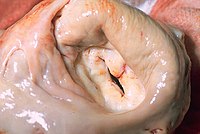
Photo from wikipedia
OBJECTIVE To determine characteristics of and outcomes for dogs with congenital distal ureteral orifice stenosis (CDUOS) treated by cystoscopic-guided laser ablation (CLA). DESIGN Retrospective case series. ANIMALS 16 client-owned dogs… Click to show full abstract
OBJECTIVE To determine characteristics of and outcomes for dogs with congenital distal ureteral orifice stenosis (CDUOS) treated by cystoscopic-guided laser ablation (CLA). DESIGN Retrospective case series. ANIMALS 16 client-owned dogs with CDUOS treated by CLA at 2 veterinary hospitals between 2010 and 2014. PROCEDURES Medical records were reviewed and data collected regarding clinical findings, imaging results, surgery characteristics, treatment, and outcome. Follow-up information was collected from dog owners and referring veterinarians via standardized interview. RESULTS Dogs included 10 males and 6 females; median age was 11.5 months (range, 4 to 112 months). Labrador Retriever (n = 6; 3 males) was the most common breed. Intramural ectopic ureteral openings were identified at the site of stenosis in 15 dogs (18/20 stenotic ureteral openings). Treatment with CLA to enlarge and relocate the stenotic opening was successful in all dogs. Median duration of anesthesia and hospitalization was 105 minutes and 24 hours, respectively. No complications were noted. Fourteen dogs remained alive (2 lost to follow-up) during a median follow-up period of 14.5 months. Owners of 11 of 13 dogs reported improvement in their dog's quality of life after CLA. The treated ureteral orifice remained patent in the 2 dogs that were reimaged. CONCLUSIONS AND CLINICAL RELEVANCE CDUOS should be considered as a differential diagnosis for dogs with idiopathic distal ureteral obstruction, particularly young male Labrador Retrievers, and was most often associated with an intramural ectopic ureter in this study. Treatment with CLA was safe and effective for opening the ureteral orifice.
Journal Title: Journal of the American Veterinary Medical Association
Year Published: 2018
Link to full text (if available)
Share on Social Media: Sign Up to like & get
recommendations!